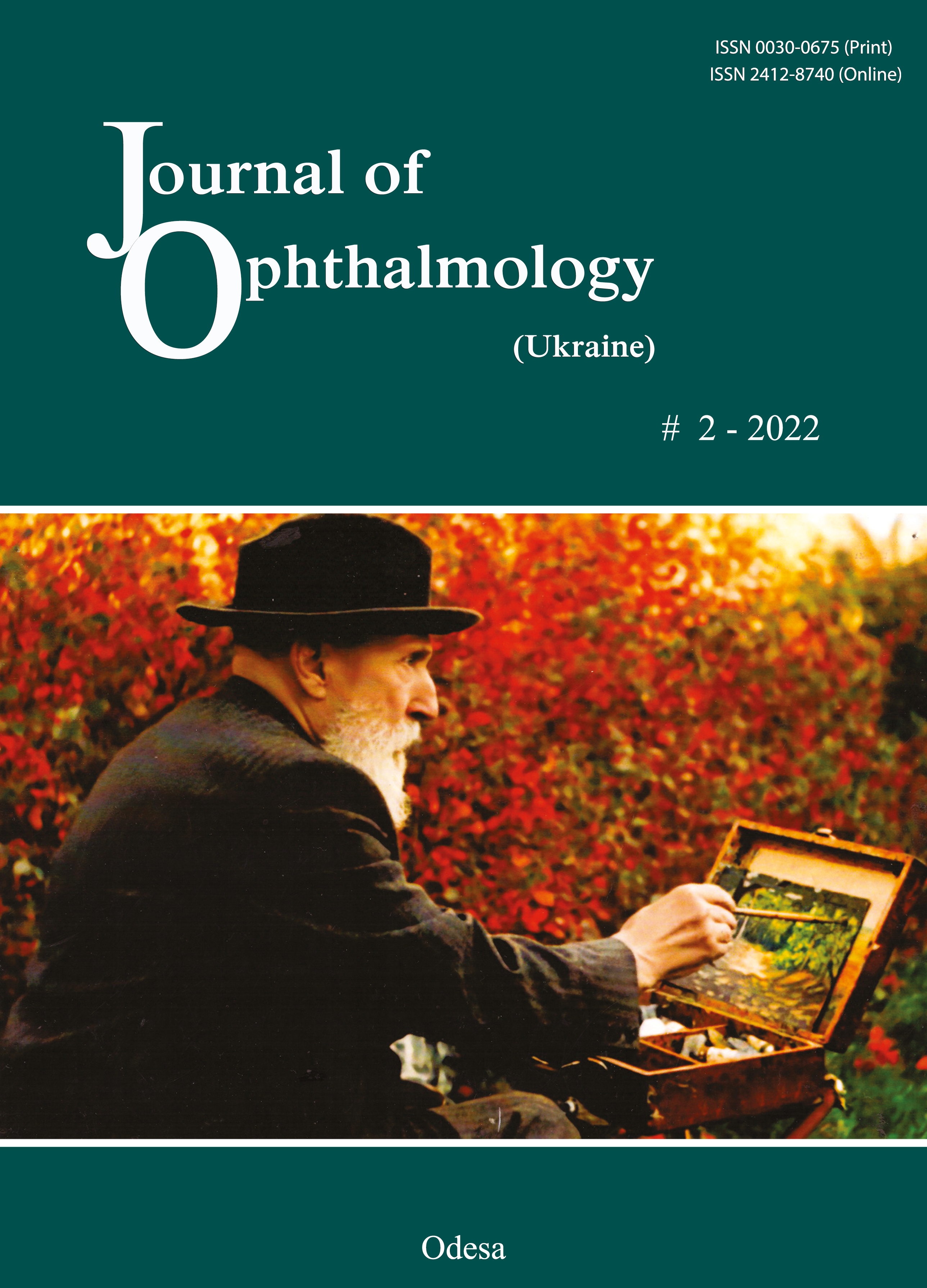Clinical features of symptomatic acquired lacrimal outflow obstruction in patients with type 2 diabetes mellitus
DOI:
https://doi.org/10.31288/oftalmolzh202223236Keywords:
acquired lacrimal outflow obstruction, type 2 diabetes mellitus, dacryocystitisAbstract
Background: Acquired lacrimal outflow obstruction (ALOO) may be either symptomatic (i.e., manifested by specific symptoms) or asymptomatic.
Purpose: To identify the clinical features of symptomatic acquired lacrimal outflow obstruction in patients with type 2 diabetes mellitus (DM2).
Material and Methods: Medical records of 284 patients with symptomatic ALOO were retrospectively examined. Of these patients, 56 (19.7%) were found to have DM2, and constituted the study group, and 228 (80.3%) had no diabetes, and constituted the control group. Specific eye examination methods included measurements of punctum size and tear meniscus height, tear production tests (Schirmer, Jones and tear film breakup tests), nasolacrimal test, tear absorbing test, reflux tests, assessment of lacrimal system balance, lacrimal irrigation, and lacrimal canaliculi probing.
Results: DM2 was found in 19.7 ± 2.4% of patients with symptomatic ALOO. We identified the clinical features of symptomatic ALOO in patients with type 2 DM. The incidence of bilateral dacryocystitis (46.4 ± 6.7%) was 1.6-fold higher; dacryocystitis (60.7 ± 6.5%) was 1.5-fold higher; punctual occlusion (30.3 ± 6.1%), 1.3-fold higher; bilateral punctual occlusion (7.1 ± 3.4%), 2.7-fold higher; membranous stenosis (9.8 ± 3.3%), twice higher; pinpoint stenosis (9.8 ± 3.3%), 1.9-fold higher; and blepharitis (71.4 ± 6.0%), 1.4-fold higher in the above patients than in patients with symptomatic ALOO in the absence of type 2 DM (р < 0.05). In addition, patients with symptomatic ALOO combined with type 2 DM were at average 8.1 years younger than non-diabetic patients with ALOO (р < 0.05).
Conclusion: DM2 was found in 19.7 ± 2.4% of patients with symptomatic ALOO. Clinical features of symptomatic ALOO were noted in patients with DM2.
References
1.Valiyeva GN. [Remote results of transcanalicular laser-assisted dacryocystorhinostomy and measures to prevent recurrent nasolacrimal duct obstruction]. [Thesis for the Degree of Cand Sc (Med)]. Ufa: Ufa Eye Research Institute; 2006. Russian.
2.Linberg JV, McCormick SA. Primary acquired nasolacrimal duct obstruction. A clinicopathologic report and biopsy technique. Ophthalmology. 1986 Aug;93(8):1055-63. https://doi.org/10.1016/S0161-6420(86)33620-0
3.Woog JJ. The incidence of symptomatic acquired lacrimal outflow obstruction among residents of Olmsted County, Minnesota, 1976-2000 (an American Ophthalmological Society thesis). Trans Am Ophthalmol Soc. 2007;105:649-66.
4.Rabina G, Golan S, Neudorfer M, Leibovitch I. External Dacryocystorhinostomy: Characteristics and Surgical Outcomes in Patients with and without Previous Dacryocystitis. J Ophthalmol. 2013;2013:287524. https://doi.org/10.1155/2013/287524
5.Sung JY, Lee YH, Kim KN, Kang TS, Lee SB. Surgical outcomes of endoscopic dacryocystorhinostomy: analysis of age effect. Sci Rep. 2019 Dec 27;9(1):19861. https://doi.org/10.1038/s41598-019-56491-y
6.Hur MC, Jin SW, Roh MS, Jeong WJ, Ryu WY, Kwon YH, Ahn HB. Classification of Lacrimal Punctal Stenosis and Its Related Histopathological Feature in Patients with Epiphora. Korean J Ophthalmol. 2017 Oct;31(5):375-382. https://doi.org/10.3341/kjo.2016.0129
7.Kashkouli MB, Pakdel F, Kiavash V. Assessment and management of proximal and incomplete symptomatic obstruction of the lacrimal drainage system. Middle East Afr J Ophthalmol. 2012 Jan;19(1):60-9. https://doi.org/10.4103/0974-9233.92117
8.Bartley GB. Acquired lacrimal drainage obstruction: an etiologic classification system, case reports, and a review of the literature. Part 1. Ophthalmic Plast Reconstr Surg. 1992;8(4):237-242. https://doi.org/10.1097/00002341-199212000-00001
9.Tsai S, Clemente-Casares X, Revelo XS, Winer S, Winer DA. Are obesity-related insulin resistance and type 2 diabetes autoimmune diseases? Diabetes. 2015 Jun;64(6):1886-97. https://doi.org/10.2337/db14-1488
10.Kesarwani D, Rizvi SWA, Khan AA, Amitava AK, Vasenwala SM, Siddiqui Z. Tear film and ocular surface dysfunction in diabetes mellitus in an Indian population. Indian J Ophthalmol. 2017 Apr;65(4):301-304. https://doi.org/10.4103/ijo.IJO_939_15
Downloads
Published
How to Cite
Issue
Section
License
Copyright (c) 2025 П. А. Бездітко, Н. М. Безега

This work is licensed under a Creative Commons Attribution 4.0 International License.
This work is licensed under a Creative Commons Attribution 4.0 International (CC BY 4.0) that allows users to read, download, copy, distribute, print, search, or link to the full texts of the articles, or use them for any other lawful purpose, without asking prior permission from the publisher or the author as long as they cite the source.
COPYRIGHT NOTICE
Authors who publish in this journal agree to the following terms:
- Authors hold copyright immediately after publication of their works and retain publishing rights without any restrictions.
- The copyright commencement date complies the publication date of the issue, where the article is included in.
DEPOSIT POLICY
- Authors are permitted and encouraged to post their work online (e.g., in institutional repositories or on their website) during the editorial process, as it can lead to productive exchanges, as well as earlier and greater citation of published work.
- Authors are able to enter into separate, additional contractual arrangements for the non-exclusive distribution of the journal's published version of the work with an acknowledgement of its initial publication in this journal.
- Post-print (post-refereeing manuscript version) and publisher's PDF-version self-archiving is allowed.
- Archiving the pre-print (pre-refereeing manuscript version) not allowed.












